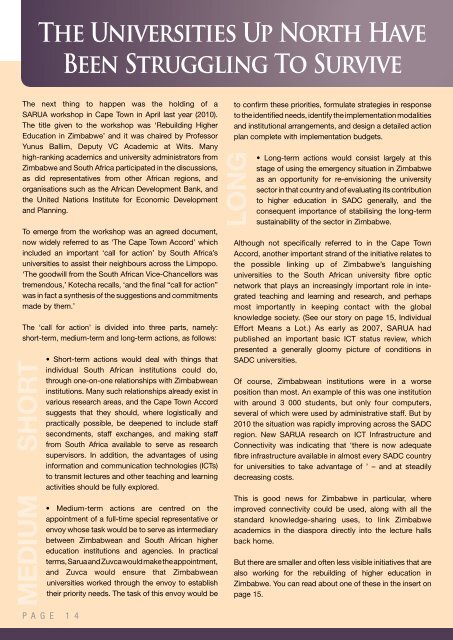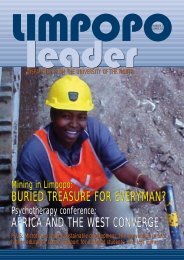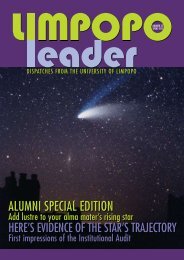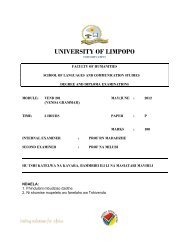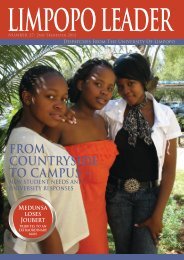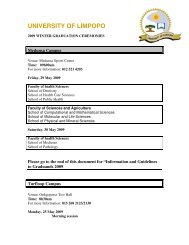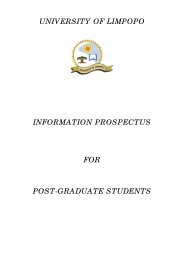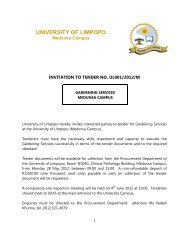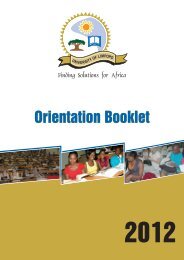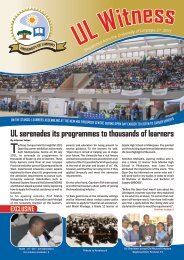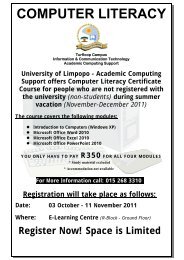Limpopo Leader - University of Limpopo
Limpopo Leader - University of Limpopo
Limpopo Leader - University of Limpopo
You also want an ePaper? Increase the reach of your titles
YUMPU automatically turns print PDFs into web optimized ePapers that Google loves.
The Universities Up North Have<br />
Been Struggling To Survive<br />
The next thing to happen was the holding <strong>of</strong> a<br />
SARUA workshop in Cape Town in April last year (2010).<br />
The title given to the workshop was ‘Rebuilding Higher<br />
Education in Zimbabwe’ and it was chaired by Pr<strong>of</strong>essor<br />
Yunus Ballim, Deputy VC Academic at Wits. Many<br />
high-ranking academics and university administrators from<br />
Zimbabwe and South Africa participated in the discussions,<br />
as did representatives from other African regions, and<br />
organisations such as the African Development Bank, and<br />
the United Nations Institute for Economic Development<br />
and Planning.<br />
To emerge from the workshop was an agreed document,<br />
now widely referred to as ‘The Cape Town Accord’ which<br />
included an important ‘call for action’ by South Africa’s<br />
universities to assist their neighbours across the <strong>Limpopo</strong>.<br />
‘The goodwill from the South African Vice-Chancellors was<br />
tremendous,’ Kotecha recalls, ‘and the final “call for action”<br />
was in fact a synthesis <strong>of</strong> the suggestions and commitments<br />
made by them.’<br />
The ‘call for action’ is divided into three parts, namely:<br />
short-term, medium-term and long-term actions, as follows:<br />
MEDIUM SHORT<br />
• Short-term actions would deal with things that<br />
individual South African institutions could do,<br />
through one-on-one relationships with Zimbabwean<br />
institutions. Many such relationships already exist in<br />
various research areas, and the Cape Town Accord<br />
suggests that they should, where logistically and<br />
practically possible, be deepened to include staff<br />
secondments, staff exchanges, and making staff<br />
from South Africa available to serve as research<br />
supervisors. In addition, the advantages <strong>of</strong> using<br />
information and communication technologies (ICTs)<br />
to transmit lectures and other teaching and learning<br />
activities should be fully explored.<br />
• Medium-term actions are centred on the<br />
appointment <strong>of</strong> a full-time special representative or<br />
envoy whose task would be to serve as intermediary<br />
between Zimbabwean and South African higher<br />
education institutions and agencies. In practical<br />
terms, Sarua and Zuvca would make the appointment,<br />
and Zuvca would ensure that Zimbabwean<br />
universities worked through the envoy to establish<br />
their priority needs. The task <strong>of</strong> this envoy would be<br />
P A G E 1 4<br />
to confirm these priorities, formulate strategies in response<br />
to the identified needs, identify the implementation modalities<br />
and institutional arrangements, and design a detailed action<br />
plan complete with implementation budgets.<br />
LONG<br />
• Long-term actions would consist largely at this<br />
stage <strong>of</strong> using the emergency situation in Zimbabwe<br />
as an opportunity for re-envisioning the university<br />
sector in that country and <strong>of</strong> evaluating its contribution<br />
to higher education in SADC generally, and the<br />
consequent importance <strong>of</strong> stabilising the long-term<br />
sustainability <strong>of</strong> the sector in Zimbabwe.<br />
Although not specifically referred to in the Cape Town<br />
Accord, another important strand <strong>of</strong> the initiative relates to<br />
the possible linking up <strong>of</strong> Zimbabwe’s languishing<br />
universities to the South African university fibre optic<br />
network that plays an increasingly important role in integrated<br />
teaching and learning and research, and perhaps<br />
most importantly in keeping contact with the global<br />
knowledge society. (See our story on page 15, Individual<br />
Effort Means a Lot.) As early as 2007, SARUA had<br />
published an important basic ICT status review, which<br />
presented a generally gloomy picture <strong>of</strong> conditions in<br />
SADC universities.<br />
Of course, Zimbabwean institutions were in a worse<br />
position than most. An example <strong>of</strong> this was one institution<br />
with around 3 000 students, but only four computers,<br />
several <strong>of</strong> which were used by administrative staff. But by<br />
2010 the situation was rapidly improving across the SADC<br />
region. New SARUA research on ICT Infrastructure and<br />
Connectivity was indicating that ‘there is now adequate<br />
fibre infrastructure available in almost every SADC country<br />
for universities to take advantage <strong>of</strong> ’ – and at steadily<br />
decreasing costs.<br />
This is good news for Zimbabwe in particular, where<br />
improved connectivity could be used, along with all the<br />
standard knowledge-sharing uses, to link Zimbabwe<br />
academics in the diaspora directly into the lecture halls<br />
back home.<br />
But there are smaller and <strong>of</strong>ten less visible initiatives that are<br />
also working for the rebuilding <strong>of</strong> higher education in<br />
Zimbabwe. You can read about one <strong>of</strong> these in the insert on<br />
page 15.


